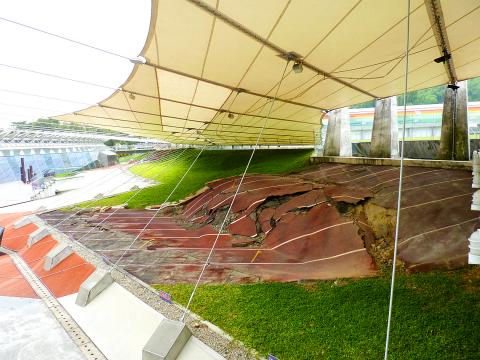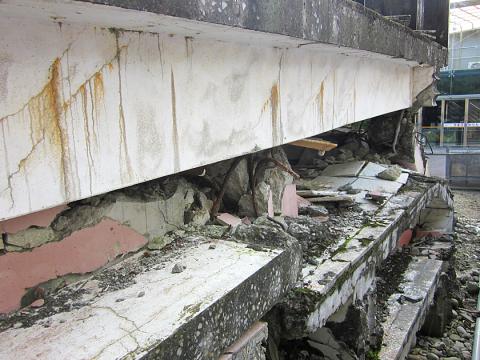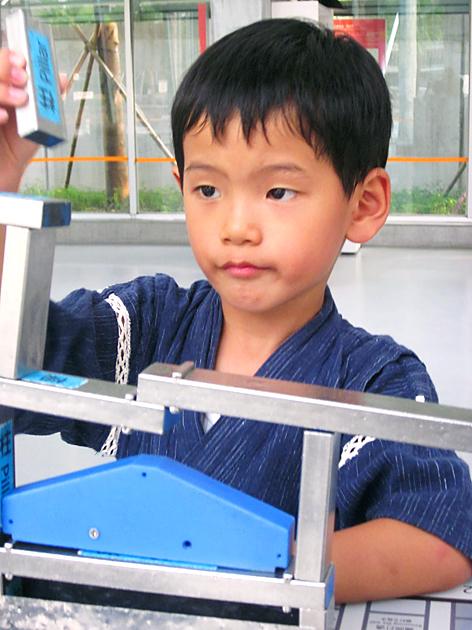Recalling the night when the nation’s worst earthquake in recent memory devastated central Taiwan, Yang Jing-chang (楊景昌) tightened his right biceps to show that he still possesses the power he summoned 14 years ago to rescue two young children from a collapsed building.
A police officer, Yang had just gotten off duty and was still at the station when he felt the ground shake. Then he heard a mother’s desperate pleas.
“Help me, help me,” said Wang to the Taipei Times, citing the woman.

Photo courtesy of 921 Earthquake Museum
With a surge of adrenaline, Yang spent the next four and a half hours with a hammer and shovel, digging through the brick remains of a demolished three-story building, eventually reuniting the mother with her son and daughter.
Yang is now a volunteer at the 921 Earthquake Museum of Taiwan in Wufeng (霧峰). He believes that the museum helps people not only to understand the natural disaster that claimed more than 2,400 lives and injured another 11,300, but also to learn about future earthquakes.
“I want to help visitors understand how to protect themselves from earthquakes,” said Yang, now 58 years old. “We need to know why buildings collapse so this doesn’t happen again.”

Photo courtesy of 921 Earthquake Museum
For visitors too young to have lived through the devastation of 1999, the museum offers games that teach lessons on earthquakes. Earlier this month, four-year-old Yang Zheng-xun (楊政勳) played with toy building materials in an interactive exhibit designed to show how top-heavy buildings without supportive walls are prone to collapse.
“It’s too difficult for him to understand the power of earthquakes,” said his mother, Lin Chiao-ling (林巧玲) of Taipei. “But we’ll come here again when he gets older.”
The museum, a 30-minute drive south of Greater Taichung, attracts over 300,000 visitors a year, half of whom are guided through on school field trips. On an annual budget of NT$60 million, it is maintained by a staff of 30 employees and 270 volunteers.

Photo courtesy of 921 Earthquake Museum
Opened in 2005 where the Kuangfu Junior High School once stood, the museum also offers visitors a glimpse into the past.
Standing before two classrooms now pancaked in a heap of concrete, museum docent Liu Ching-yen (劉青硯) said it’s fortunate that the 7.3-magnitude earthquake struck in the middle of the night, sparing the students and staff.
“The most important lesson here is how to protect yourself,” Liu said. “It’s not a matter of if a big earthquake happens again, but when.”
Throughout Taiwan, there are more than 30,000 earthquakes annually, hundreds of which are routinely felt, Liu said. Occasionally, she added, the nation will be jolted by an earthquake strong enough to inflict widespread damage and casualties.
Preparing for the inevitable, yet unpredictable, event is Liu’s mission. While encouraged by the number of youths visiting the museum, she called on more earthquake education in schools.
“Most of the kids don’t understand how powerful earthquakes can be,” she said.
“We need to talk more about how to protect ourselves.”
MUSEUM HIGHLIGHTS:
Chelungpu Fault Gallery: Showcases the 2.5-meter rise in earth that occurred when the fault ruptured
Earthquake Engineering Hall: Provides home and public safety tips, along with modern earthquake resistance technology
Image Gallery: Provides a simulated earthquake experience
Disaster Prevention Hall: Presents ways to prepare for a range of natural disasters such as earthquakes and floods
Reconstruction Records Hall: Documents the reconstruction efforts in the aftermath of the 1999 earthquake
IF YOU GO:
Where: 46 Zongzheng Road, Greater Taichung (臺中市霧峰區中正路46號)
How to get there by car: Take National Highway No.3 and exit at Wufeng Interchange to Zhongzheng Road and turn right toward Caotuen to reach the museum
Contact: (04) 2339-0906
On the Net: www.921emt.edu.tw
Hours: Open Tuesday to Sunday from 9am to 5pm
Services: Guided tours are available in Chinese, English and Japanese

Wooden houses wedged between concrete, crumbling brick facades with roofs gaping to the sky, and tiled art deco buildings down narrow alleyways: Taichung Central District’s (中區) aging architecture reveals both the allure and reality of the old downtown. From Indigenous settlement to capital under Qing Dynasty rule through to Japanese colonization, Taichung’s Central District holds a long and layered history. The bygone beauty of its streets once earned it the nickname “Little Kyoto.” Since the late eighties, however, the shifting of economic and government centers westward signaled a gradual decline in the area’s evolving fortunes. With the regeneration of the once

Even by the standards of Ukraine’s International Legion, which comprises volunteers from over 55 countries, Han has an unusual backstory. Born in Taichung, he grew up in Costa Rica — then one of Taiwan’s diplomatic allies — where a relative worked for the embassy. After attending an American international high school in San Jose, Costa Rica’s capital, Han — who prefers to use only his given name for OPSEC (operations security) reasons — moved to the US in his teens. He attended Penn State University before returning to Taiwan to work in the semiconductor industry in Kaohsiung, where he

On May 2, Chinese Nationalist Party (KMT) Chairman Eric Chu (朱立倫), at a meeting in support of Taipei city councilors at party headquarters, compared President William Lai (賴清德) to Hitler. Chu claimed that unlike any other democracy worldwide in history, no other leader was rooting out opposing parties like Lai and the Democratic Progressive Party (DPP). That his statements are wildly inaccurate was not the point. It was a rallying cry, not a history lesson. This was intentional to provoke the international diplomatic community into a response, which was promptly provided. Both the German and Israeli offices issued statements on Facebook

Perched on Thailand’s border with Myanmar, Arunothai is a dusty crossroads town, a nowheresville that could be the setting of some Southeast Asian spaghetti Western. Its main street is the final, dead-end section of the two-lane highway from Chiang Mai, Thailand’s second largest city 120kms south, and the heart of the kingdom’s mountainous north. At the town boundary, a Chinese-style arch capped with dragons also bears Thai script declaring fealty to Bangkok’s royal family: “Long live the King!” Further on, Chinese lanterns line the main street, and on the hillsides, courtyard homes sit among warrens of narrow, winding alleyways and